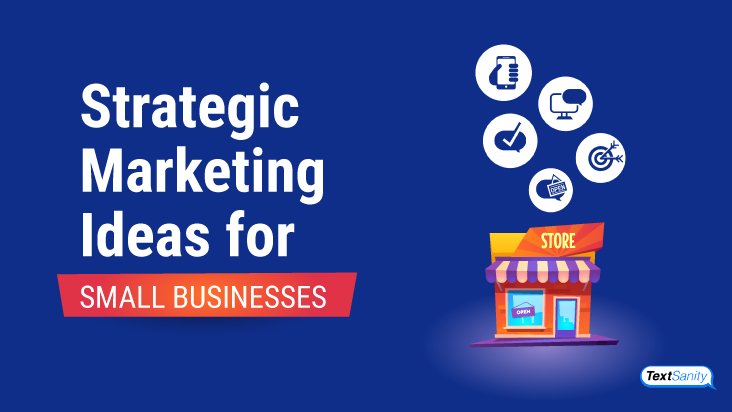7 Strategic Marketing Ideas for Small Businesses
Small businesses rely a lot on successful marketing. In turn, successful marketing relies on a strategic marketing plan. Marketing is how businesses attract the customers they need to stay operation and promote growth. Therefore, marketing ideas for small businesses is a key factor.

Marketing strategies are created to help a business reach sales goals and achieve branding initiatives. Through various tactics and channels, strategic plans are implemented to reach the right consumers to bring in business.
When devising a marketing strategy, it’s important for small businesses to ask certain questions:
- What are our goals?
- What makes sense for our small business?
- Are you already doing what you need to?
- How much are we able and willing to spend?
- Where should we start?
- What should we add? Or change?
There’s no one way to market your small business effectively. Most successful marketing strategies use more than one channel for marketing. It’s important to know what strategic options are out there for your small business to use. Here are seven strategic marketing ideas for small businesses.
![]()
1. Identify your brand
As a small business, big companies like Nike and Apple may seem like a lofty place to glean inspiration, but the brands you already know are a great place to learn what consumers expect from companies today. Customers and potential customers must know what your business does, what it stands for, and what the company’s identity is going to be.

Branding is more than a logo. Steve Jobs saw the marketing genius in Nike more than 20 years ago because when consumers see that swoosh symbol, they don’t just think about shoes — they have a connection to the ideals that the company communicates.
During Apple’s rebranding efforts in the late ’90s, a quote emerged that said, “People who are crazy enough to think that they can change the world are the ones that actually do!” They launched a “Think Different” campaign and considered their rise to success that followed.
Think about the commercials you see. Rarely do you see a product anymore. Companies learned to advertise a lifestyle to their target market rather than a product. This visual of the consumer’s own goals and aspirations helps them identify with a company.
Consumers also want to know the companies they purchase from have similar conscience to their own. A consumer is more likely to buy from a company that shares their ethics and morals, even when a similar product is available.
Your small business may not have global goals, but the takeaway is the same. Consumers respond to developing a connection to a company, not just to the product it provides. When you know your brand’s identity, it’s easier to market to and understand your target audience.

2. Know your audience
Once you create your business’ brand identity, the next step is to understand your audience or customer. What works for one business may not work for another. So, it’s vital you know your niche group and specifically market to them.

It’s very likely you know your product really well as a small business, but there are some questions to ask when you’re getting to know target customers:
- How old are they?
-
Where do they live?
-
How do they like to shop?
-
How do they like to communicate?
-
What is their demographic?
When you know the answers to these questions, it’s easier to develop an overall marketing strategy and establish what marketing channels will be the most effective.

3. Develop a website
Websites are essential to any business. Think about your own experiences as a customer. When was the last time you tried a new business that didn’t have a website? Websites are the modern-day storefront. A quality website equates to an attractive digital storefront that can bring in business.
Companies use websites to provide customers with important information, make sales, increase web traffic from internet searches, and promote brand imaging and social media communications.
You definitely don’t have to be a big business to benefit from having a website. If your small business hasn’t created one yet, this is an important step in any marketing strategy.
![]()
4. Think about SEO
Once you’ve developed a website, work on search engine optimization or SEO. SEO is the process of improving your website to increase online traffic and visibility. So, when consumers search for your business or product, they find it.

For example, if someone searches “restaurants near me”, and you own a restaurant, you want to be the first one that pops up. By becoming more visible online, you increase your visibility to prospective and even current customers.
Think about words relating to your business. Don’t be afraid to think outside the box. If you sell jewelry, ask yourself what describes you? Affordable? Unique? Handmade? Quality? Many words relevant to your business will attract customers.
When you understand your brand and audience, words come easily. Additionally, words describing your demographic also improve your SEO.

5. Socialize
Social media didn’t take long to become an important small business asset. Social media posts communicate your company’s brand image, and provide a way for customers to give valuable feedback.
Interacting with a company online establishes a relationship with customers. Establishing a relationship promotes trust, loyalty, and increases brand awareness. Plus, the shareability of social media amplifies the power of word-of-mouth marketing, and word-of-mouth marketing is the oldest marketing strategy.
When people talk about your business, they’re thinking about your business. Social media broadens your reach and increases the customers thinking about your business.
As a small business, it may not be feasible to be on every social media platform. There’s nothing wrong with focusing your efforts on the platform reaching your target audience most effectively.
![]()
6. Use email too
Good ol’ email. It’s hard to believe that email only became popular and commonplace less than thirty years ago. When it comes to marketing, email is the cornerstone of digital communication.

About half the world’s population uses email. Users send and receive about 121 business emails per day. The average open rate for emails ranges between 20 and 40 percent. As long as you follow typical email marketing etiquette, it’s a cost-effective business marketing strategy.

7. Text
Text marketing or SMS marketing is quickly becoming the preferred marketing channel for consumers and businesses alike. Like email, consumers opt-in to this form of marketing and remain receptive to it.
Seventy percent of the world’s population has a cell phone, and virtually all of them are capable of receiving text messages. Text messages are received almost instantly, and boast an open rate of about 98% within three minutes.
Text marketing gives you instant access to your customers’ attention remotely. To capitalize on this amazing accessibility to your customer, there are some important things to remember.
- Brevity: Keep it short and sweet.
-
Clarity: Leave no room for being misunderstood.
-
Consent: Texting works because consumers consent to contact.
-
Timing: Instant delivery puts the timing in your hands.
-
Value: Consumers expect value in return for the privilege of allowing you to text them.
Texting is popular among all demographics. In fact, all businesses benefit from this low-cost marketing strategy. Like many other strategies, measurable results are key. One added benefit, though, is how quickly its effectiveness becomes evident.
Text marketing adjustments are easy to make and quick, saving you time and money. Familiarize yourself with keywords, automated responses, and how to utilize a text marketing platforms’ URL shortener. In addition, promote opt-in’s with other marketing channels.
Summary
As a small business, marketing may sound daunting. But mastering marketing is essential to your success. Know your needs, your customers, and your budget. And impliment the strategic marketing ideas for small businesses above.
Remember, even small businesses need a diverse and cost-effective marketing strategy. The internet makes growing your business and marketing yourself easier and more attainable.
As with any business strategy, it’s important to periodically take stock of your goals. Figure out what’s working and what’s not. Don’t be afraid to make changes. And finally, be open to new techniques.


